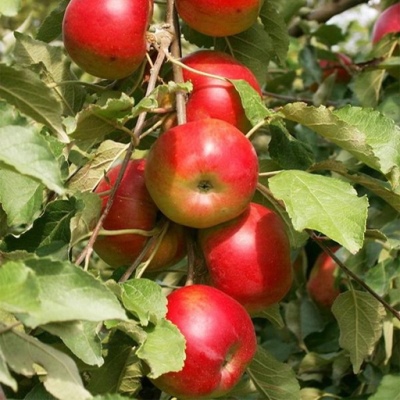
- Authors: Russia, Moscow region
- Taste: sweet and sour
- Scent: strong, nutmeg
- Fruit weight, g: 75-135
- Fruit size: average
- Yield: up to 20-35 kg / tree
- The beginning of fruiting varieties: from 3-4 years
- Ripening terms: early autumn
- Removable maturity: end of August - beginning of September
- Keeping quality: 50 days
Despite the successes of the Ural, Siberian and Volga breeding schools, the metropolitan and Moscow region specialists are not giving up their positions. One of the results of their efforts was the Barguzin apple tree. A close acquaintance with the features of this small-sized tree will be very useful for summer residents.
Breeding history of the variety
The plant was bred thanks to the efforts of the famous professor Kichin. The breeding work was completed by 1976. The culture was assigned the working index KV-53, which is now sometimes used as a synonym. The experimental station of the famous VNIISPK served as a platform for manipulations. This level of development has resulted in impressive results.
Description of the variety
You can grow Barguzin in:
- Crimea;
- various regions of the North Caucasus;
- Moscow and Leningrad regions;
- the middle lane.
The height of the trunk is from 1.5 to 2 m, but the rootstock can affect the growth, and sometimes it reaches 3 m. The crown is relatively small and looks nice. Light green foliage is perceived quite well. The shoots, graceful in shape, are distinguished by excellent brilliance. The columnar tree is practically the dream of an apple grower, it is so easy to care for it.
Features, pros and cons
No noticeable weaknesses were found in the Barguzin apple tree. With competent agricultural technology and taking into account the properties of the plant, problems are excluded in principle. The virtues of culture are:
- high quality fruit;
- small occupied space;
- excellent resistance to cold;
- rapid appearance of apples;
- solid immunity to fungal infections.
Ripening and fruiting
Barguzin is one of the early autumn apple trees. Fruit picking under favorable conditions can be in late August or early September. The earliest fruits appear on 3 or 4 year old trees.
Yield
Compared to other columnar apple trees, Barguzin is a real leader. The tree allows you to get from 20 to 35 kg of apples. But if you use dwarf rootstocks instead of ordinary ones, then a yield over 10 kg will be unattainable.
The plant is completely self-fertile and delivers all of its results unaided. Whether the presence of pollinating trees has an impact on the result has not yet been reliably established, there are only assumptions.
Fruits and their taste
Barguzin's apples are bright red with a yellowish tint. They are characterized by a transitional shape from a circle to a cone. The mass of a single fruit ranges from 0.075 to 0.135 kg. Other important information:
- the peel is thin, but dense;
- the pulp is tender and juicy, has a granular structure;
- keeping quality is low (does not exceed 50 days);
- the indicator of the tasting examination - from 4.65 to 4.78 points.

Growing features
The variety tolerates winter cold well. The temperature of -27 degrees is not too critical for him. At the same time, it must be planted in sunny places. A distance of 1 to 1.5 m should be maintained between individual trees.
When using tent structures, frost resistance can be increased to -30 degrees. However, drafts and cold winds can pose a risk, as well as excessive moisture - both during precipitation and during snowmelt.
Barguzin is practically not susceptible to plant pathologies. The defeat, if it does occur, is almost always limited to the leaves. But special preventive treatments are in any case necessary and obligatory for this culture.
Groundwater can reach up to 1.5-1.7 m. If they are even closer to the surface, powerful drainage will be required - although sometimes it is better to plant the apple tree somewhere else.
Planting pits are prepared 2-3 weeks before disembarkation. Doing this before is hardly worth it. The stakes for the garter must be buried on the north side of the pit. The surface of the hole must be watered using 30 to 45 liters of water. The land is advised to mulch, otherwise this water will quickly go away.
Other recommendations:
- cover trees for the winter with spruce branches;
- protect them from insects by lime treatment;
- loosen the trunk circle in early spring and late autumn;
- avoid over-watering.
You will not have to rejuvenate Barguzin, because he does not live for more than 15-25 years.






The apple tree is a popular fruit crop among gardeners. It can be found in many summer cottages. But at the same time, such trees are often affected by various diseases. It is very important to recognize the disease in time and carry out the necessary procedures for a speedy recovery. Otherwise, the fruits will be spoiled, and the tree itself may die altogether.












































































